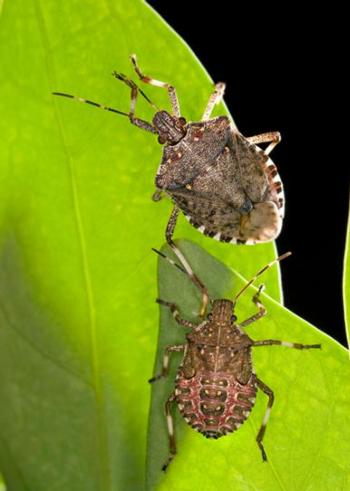INSECT HOT TOPICS: Brown marmorated stink bug
by James A. Bethke

BMSB, Halyomorpha halys Stål (Insecta: Hemiptera: Pentatomidae), is native to China, Japan, Korea and Taiwan. It is a major economic pest in these countries, attacking a variety of high value crops. In the United States, BMSB was first collected in Pennsylvania in 1998 — researchers speculate that it arrived on a cargo ship from Asia — and it currently has been sighted in 29 states. In the Pacific Northwest, it has become established in Oregon and it has been found in Vancouver, Washington; in California, it was first found established in Los Angeles County in the urban environment.
The California Department of Food and Agriculture (CDFA) border check stations have intercepted BMSB 24 times from 2006 to 2010 in vehicles coming from the eastern United States. From 2002 to 2006, BMSB has been observed in the following 10 California counties: Alameda, Contra Costa, Monterey, Riverside, Sacramento, San Diego, San Francisco, San Joaquin, Santa Clara and Solano. All of these detections have been associated with people, vehicles or parcels that originated from infested areas in the eastern United States.
BMSB can cause severe damage to a variety of host plants. Some reports in Pennsylvania have indicated that peach growers lost as much as 50 to 60% of their crop to BMSB, which feeds directly on the fruit. Other fruits that BMSB attacks include apple and pear. BMSB also damages vegetable crops such as corn, beans, peppers and tomatoes, and many ornamental plants such as butterfly bush (Buddleia spp.), empress tree (Paulownia tomentosa), hibiscus, zinnia and sunflower.
Unfortunately, when the cooler weather begins in early winter, BMSB aggregates in urban areas, including homes, looking for a warm place to overwinter. They are no threat to humans, but they are not called stink bugs for no reason; if disturbed, they will emit a strong unpleasant odor. When it begins to warm again in the spring, the aestivating adults will migrate back to host plants, mate, lay their eggs and cause plant damage.
USDA-ARS researchers have documented two full generations of BMSB in eastern states beginning with the previous year’s overwintered adults in the spring. A similar generational trend will likely be seen in California. BMSB nymphs develop through five nymphal stages before becoming adults. It is hypothesized that a second generation will be present by August that will become the overwintering generation, likely following the same developmental trend as that of the glassy-winged sharpshooter. Warm spring and summer conditions could permit the development of a third generation in California. However in parts of sub-tropical China, records indicate that four to six generations per year may be possible.
BMSB is morphologically similar to many other stink bugs, including numerous species found in California. To distinguish them from other stink bugs, look for both white and black bands on the last two antennal segments with alternating white and black triangles on the outside edge of the abdomen (fig. 1). If you have a mobile device, you could download an app called Stink Bug Scout. This app helps identify stink bugs using lots of photos.
Currently the CDFA rates BMSB as a “B”-rated pest like the glassy-winged sharpshooter. This means that nursery stock found infested must be cleaned before it can be sold, and our border stations can require treatment or reject shipments that are infested. However, CDFA has not enacted any additional quarantine regulations, nor are they conducting any surveys or other treatments for BMSB in natural environments.
For more information about the brown marmorated stink bug, see the following web sites:
http://www.ipm.ucdavis.edu/pestalert/pabrownmarmorated.html
http://www.ces.ncsu.edu/depts/ent/notes/O&T/trees/note148/note148.html
http://www.oregon.gov/ODA/PLANT/docs/pdf/ippm_bmsb_alert2010.pdf?ga=t http://www.wpdn.org/webfm_send/129
http://acwm.lacounty.gov/pdf/Brownmarmorated.pdf
http://www.epa.gov/pesticides/controlling/stinkbugs/
http://www.ars.usda.gov/is/AR/archive/jul09/bug0709.htm
http://www.ars.usda.gov/is/AR/archive/jul09/bug0709.pdf
http://stream.ucanr.org/fps_stinkbug/index.html
http://entnemdept.ufl.edu/creatures/veg/bean/brown_marmorated_stink_bug.htm
http://ento.psu.edu/extension/factsheets/brown-marmorated-stink-bug
http://www.ndsu.nodak.edu/ndsu/rider/Pentatomoidea/Species_Cappaeini/Halyomorpha_halys.htm
http://www.massnrc.org/pests/linkeddocuments/BMSBFactSheet.pdf
http://njaes.rutgers.edu/pubs/plantandpestadvisory/2011/fr061411.pdf
http://ucanr.org/blogs/blogcore/postdetail.cfm?postnum=6120
James A. Bethke is Farm Advisor for Nurseries and Floriculture, UC Cooperative Extension, San Diego and Riverside Counties.












